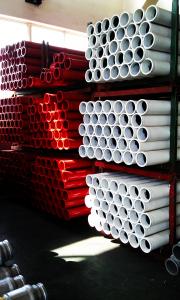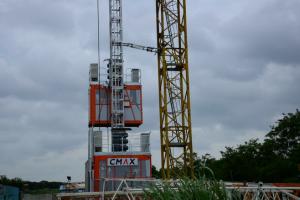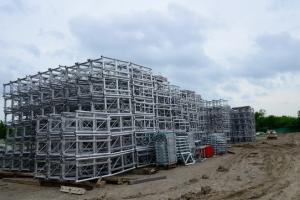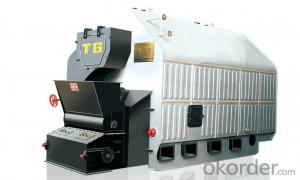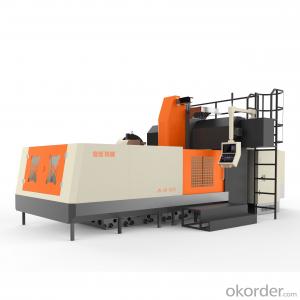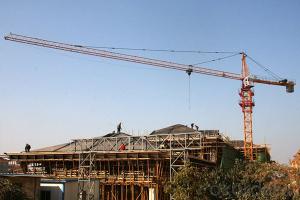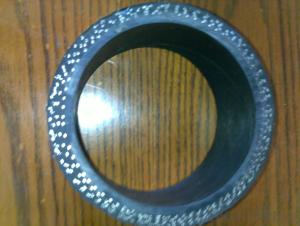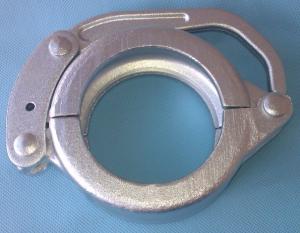Concrete Pump Parts Steel Pipe Delivery Pipe ST52 DN125
- Loading Port:
- Tianjin
- Payment Terms:
- TT OR LC
- Min Order Qty:
- 256 pc
- Supply Capability:
- 10000 pc/month
OKorder Service Pledge
OKorder Financial Service
You Might Also Like
Product Description:
Used for concrete transportation in construction work
Our concrete pump pipes have been successfully exported to many countries from 1998, Our main markets as below: Middle East, Southeast Asia, America, Brazil, Italy, Russia, South Africa etc.
Main Product Features:
Application
Used for concrete transportation in construction work
Length
1m-6m or according to the customer's requirement
Material
ST52
Thickness
4.0mm/4.2mm/4.5mm/5mm/5.2mm/5.5mm.ect.
Weight
38KG/40KG/43KG/48KG/52KG
Color
as clients required
Using life
12.000m³/15.000m³/25.000m³/35.000m³/50.000m³
Collar
148 or 157mmTwin wall flange
Feature
High Wear-resistant , long service life , lower cost
Product Specifications:
Dimension: DN125
Length: 2m
Thickness: 4.1mm
Material: ST52
Characteristics: double-ends flange
Package: Seaworthy packing or as customers’ request.
FAQ:
Q1: How to confirm that your pipes could be used in our pump?
A1: We have been providing parts for nearly ten years, and cooperating with the agent of the world famous brand, possess near every kind of pipe in the market. What is more, we can produce as the customers’ request with drawing provided.
Q2: How do we guarantee the quality of our products?
A2: We have established an advanced quality management system which conducts strict quality tests at every step, from raw materials to the final product.
Q3: How soon can we receive the product after purchase?
A3: Within three days of placing an order, we will begin production. The specific shipping date is dependent upon international and government factors, but is typically 5-15 workdays.
Q4: If we can produce some Concrete Pump Truck Parts according to customers request?
A4: Yes, we can produce Concrete Pump Truck Parts according to the difference country situations to make it suitable to the market and customers. We have very professional technical team to make the design.
Q5: How to make a quick resolution for after service?
A5: OKorder and our manufacture both have overseas branches all-around of world, IF needed, the seller shall dispatch 2 engineers to the buyer's site for supervision of training. The buyer shall make available of necessary facilities & skilled personnel at site for training.

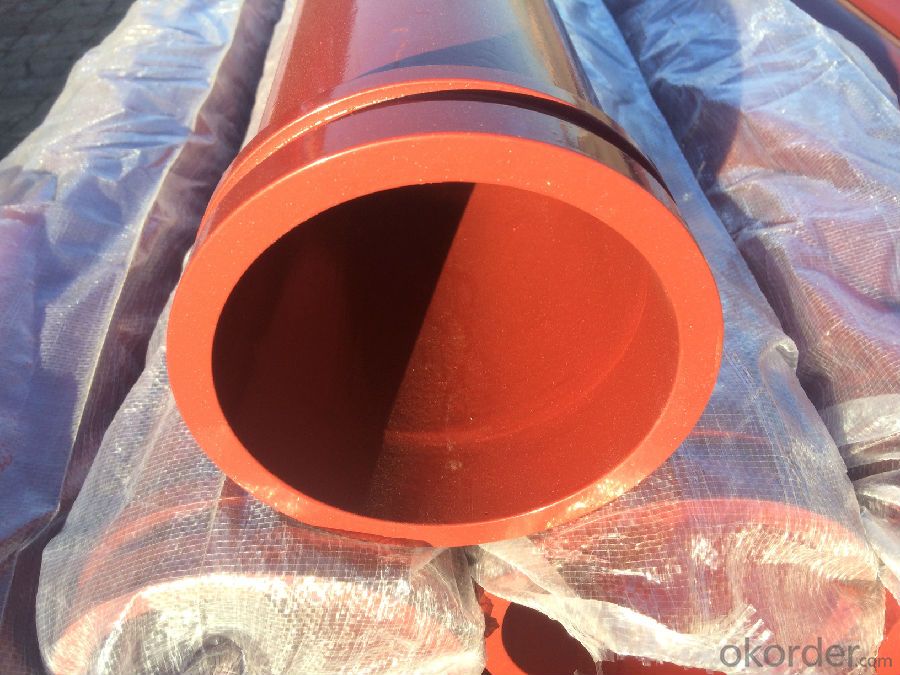
- Q:How often should hydraulic cylinders be inspected or replaced in a concrete pump?
- Hydraulic cylinders in a concrete pump should be inspected regularly, ideally every 6 to 12 months, to ensure their proper functioning. Replacement of hydraulic cylinders should be done only when necessary, such as in cases of significant wear and tear, severe damage, or if they fail to meet safety standards.
- Q:What are the advantages of using stainless steel components in concrete pump spare parts?
- Concrete pump spare parts can benefit greatly from the use of stainless steel components. Firstly, stainless steel is highly resistant to corrosion and rust, which is essential in the concrete pumping industry where the equipment is constantly exposed to water, chemicals, and abrasive materials. By incorporating stainless steel components, the spare parts are able to endure these harsh conditions and have a longer lifespan compared to alternative materials. Secondly, stainless steel boasts exceptional strength and durability, enabling it to withstand high pressure and heavy loads. This makes it an ideal choice for concrete pump spare parts, ensuring the equipment operates efficiently and effectively without the risk of failure or breakdown. Moreover, stainless steel is known for its hygienic properties and ease of cleaning. In the concrete pumping industry, maintaining cleanliness is of utmost importance to prevent contamination and preserve the quality of transported concrete. Stainless steel components can be effortlessly cleaned and sanitized, guaranteeing that the spare parts meet the highest hygiene standards. Additionally, stainless steel offers an aesthetic appeal with its sleek and modern appearance. This can enhance the overall look of the concrete pump, which is particularly significant for businesses prioritizing their brand image and aiming to project a professional and high-quality impression to their clients. Lastly, stainless steel is an environmentally friendly option. It is completely recyclable, allowing for reuse and repurposing, thereby reducing the need for new materials and minimizing waste. This makes stainless steel components a sustainable choice for concrete pump spare parts. In conclusion, the use of stainless steel components in concrete pump spare parts provides numerous advantages such as corrosion resistance, strength, cleanliness, aesthetic appeal, and environmental sustainability. These benefits make stainless steel an excellent choice for the construction industry, ensuring reliable and efficient operation of concrete pumps.
- Q:Are there any specific guidelines for the installation of pipe or hose assemblies in concrete pump spare parts?
- Concrete pump spare parts have specific guidelines for the installation of pipe or hose assemblies, which are crucial for the pump system's proper and safe functioning. To ensure this, here are some key guidelines to consider: 1. Size and Compatibility: The pipe or hose assemblies must be appropriate in size and compatible with the concrete pump system. They should meet the pump's specifications and be designed for the intended application. 2. Correct Alignment: It is essential to install the pipe or hose assemblies straight, without any kinks or bends that may restrict the flow of concrete or cause blockages, thus ensuring efficient operation. 3. Secure Connections: To prevent leaks or disconnections during operation, all connections, including fittings and couplings, should be securely tightened. It is advisable to use proper tools and techniques to ensure reliable and tight connections. 4. Support and Protection: Proper support and protection of pipe or hose assemblies are necessary to prevent damage or wear. They should be securely fastened to minimize excessive movement or vibration during pumping operations. 5. Clearances and Accessibility: Maintaining sufficient clearances between the pipe or hose assemblies and surrounding structures or equipment allows for easy inspection, maintenance, and replacement if necessary. 6. Proper Sealing: Suitable sealing materials should be used to properly seal all joints and connections. This is crucial for maintaining the pumping system's integrity and preventing any environmental or safety hazards caused by leakage. 7. Regular Inspection and Maintenance: Regularly inspecting the pipe or hose assemblies for signs of wear, damage, or degradation is important. Promptly addressing any issues ensures the continued safe operation of the concrete pump system. By following these guidelines, the proper installation of pipe or hose assemblies in concrete pump spare parts can be ensured, promoting safe and efficient concrete pumping operations. It is also advisable to consult the manufacturer's recommendations and refer to any specific guidelines provided with the spare parts.
- Q:What are the different types of concrete pump hopper agitator shaft seals?
- There are various types of concrete pump hopper agitator shaft seals, including packing seals, mechanical seals, and lip seals.
- Q:How do I properly maintain and replace hydraulic motors in concrete pump spare parts?
- Proper maintenance and replacement of hydraulic motors in concrete pump spare parts is crucial to ensure the smooth operation and longevity of the equipment. Here are some steps to guide you in maintaining and replacing hydraulic motors effectively: 1. Regular Inspection: Perform routine inspections of the hydraulic motors to identify any signs of wear, damage, or leaks. Check the fluid levels and ensure they are at the recommended levels. 2. Cleanliness: Keep the hydraulic motors clean by removing any dirt, debris, or contaminants. This helps prevent the motors from overheating and minimizes the risk of damage to the internal components. 3. Fluid Maintenance: Regularly check and change the hydraulic fluid according to the manufacturer's recommendations. Clean and replace the filters to ensure the fluid is free from any particles that can cause damage to the motors. 4. Lubrication: Lubricate the hydraulic motors as per the manufacturer's instructions. This helps reduce friction and wear on moving parts, improving the overall performance and lifespan of the motors. 5. Proper Usage: Operate the concrete pump within the recommended load and pressure limits specified by the manufacturer. Overloading or excessive pressure can cause stress on the hydraulic motors, leading to premature failure. 6. Timely Replacement: Keep track of the service life and usage of the hydraulic motors. Over time, these motors may wear out and become less efficient. Replace them promptly when necessary to prevent any disruption to the concrete pumping operations. 7. Seek Professional Assistance: If you are unsure about maintaining or replacing hydraulic motors, it is advisable to seek professional assistance. They have the expertise and knowledge to carry out the necessary tasks correctly, ensuring the safety and optimal performance of the concrete pump spare parts. By following these steps, you can properly maintain and replace hydraulic motors in concrete pump spare parts, ensuring the longevity and efficiency of your equipment.
- Q:How can a malfunctioning control lever affect the pump's operation?
- A malfunctioning control lever can significantly impact the pump's operation. It may cause the pump to operate at incorrect speeds, resulting in inefficient performance or potential damage to the pump. Additionally, a malfunctioning control lever can lead to improper fluid flow control, leading to inconsistent or inaccurate output. Overall, it is crucial to promptly address any issues with the control lever to ensure the pump operates reliably and efficiently.
- Q:Are there any specific troubleshooting steps for identifying issues with concrete pump spare parts?
- Yes, there are specific troubleshooting steps that can be followed to identify issues with concrete pump spare parts. 1. Visual Inspection: Conduct a thorough visual inspection of the spare parts, looking for any signs of wear, damage, or misalignment. Check for cracks, breaks, or any other visible signs of damage. 2. Functionality Test: Test the functionality of the spare parts by operating the concrete pump. Pay attention to any abnormal noises, vibrations, or irregular movements. This can help identify issues with the spare parts. 3. Pressure Test: Perform a pressure test to ensure that the spare parts can handle the required pressure. This can be done by connecting a pressure gauge to the pump and checking if it reaches the desired pressure levels. Any abnormal pressure fluctuations can indicate issues with the spare parts. 4. Flow Test: Conduct a flow test to evaluate the flow rate of the concrete through the pump. Check if the flow is consistent and smooth. Any blockages or irregular flow patterns can indicate issues with the spare parts. 5. Check for Leaks: Inspect the spare parts for any leaks or fluid seepage. Leaks can indicate faulty seals, gaskets, or fittings. Use a suitable leak detection method, such as using a dye or pressure test, to identify the source of the leak. 6. Consult Technical Manuals: Refer to the technical manuals provided by the manufacturer for troubleshooting guidelines specific to the concrete pump spare parts. These manuals often contain detailed troubleshooting steps and recommended solutions for common issues. 7. Seek Expert Advice: If you are unable to identify the issue or troubleshoot effectively, it is advisable to consult with a qualified technician or the manufacturer's technical support team. They can provide expert guidance and assistance in identifying and resolving complex issues with concrete pump spare parts. By following these troubleshooting steps, it becomes easier to identify any issues with concrete pump spare parts and take appropriate measures to address them promptly.
- Q:How often should hopper grate springs be inspected or replaced in a concrete pump?
- Hopper grate springs in a concrete pump should be inspected regularly, ideally on a monthly basis, to ensure their proper functioning. However, the actual replacement of these springs depends on various factors such as the usage intensity, wear and tear, and manufacturer's recommendations. It is essential to monitor their condition closely and replace them promptly if any signs of damage or fatigue are observed.
- Q:How often should hopper cylinders be inspected or replaced in a concrete pump?
- Hopper cylinders in a concrete pump should be inspected regularly, ideally after every use, to ensure their proper functioning and prevent any potential issues. If any signs of wear, damage, or decreased performance are noticed, it is recommended to replace the hopper cylinders immediately to maintain the efficiency and safety of the concrete pump.
- Q:What is the function of a concrete pump hopper grate clamp?
- A concrete pump hopper grate clamp serves the purpose of securing the hopper grate on a concrete pump. This device ensures that the hopper grate remains fixed in position, preventing the entry of large debris and foreign objects into the pump system. The clamp is specifically designed to tightly hold the hopper grate, guaranteeing its stability during the pumping process. Its role is to preserve the integrity of the pump system and avert any potential damage or blockages caused by unwanted materials. In summary, a concrete pump hopper grate clamp functions as a dependable and secure method to maintain the hopper grate in place, facilitating efficient and seamless concrete pumping operations.
1. Manufacturer Overview |
|
|---|---|
| Location | |
| Year Established | |
| Annual Output Value | |
| Main Markets | |
| Company Certifications | |
2. Manufacturer Certificates |
|
|---|---|
| a) Certification Name | |
| Range | |
| Reference | |
| Validity Period | |
3. Manufacturer Capability |
|
|---|---|
| a)Trade Capacity | |
| Nearest Port | |
| Export Percentage | |
| No.of Employees in Trade Department | |
| Language Spoken: | |
| b)Factory Information | |
| Factory Size: | |
| No. of Production Lines | |
| Contract Manufacturing | |
| Product Price Range | |
Send your message to us
Concrete Pump Parts Steel Pipe Delivery Pipe ST52 DN125
- Loading Port:
- Tianjin
- Payment Terms:
- TT OR LC
- Min Order Qty:
- 256 pc
- Supply Capability:
- 10000 pc/month
OKorder Service Pledge
OKorder Financial Service
Similar products
New products
Hot products
Related keywords
